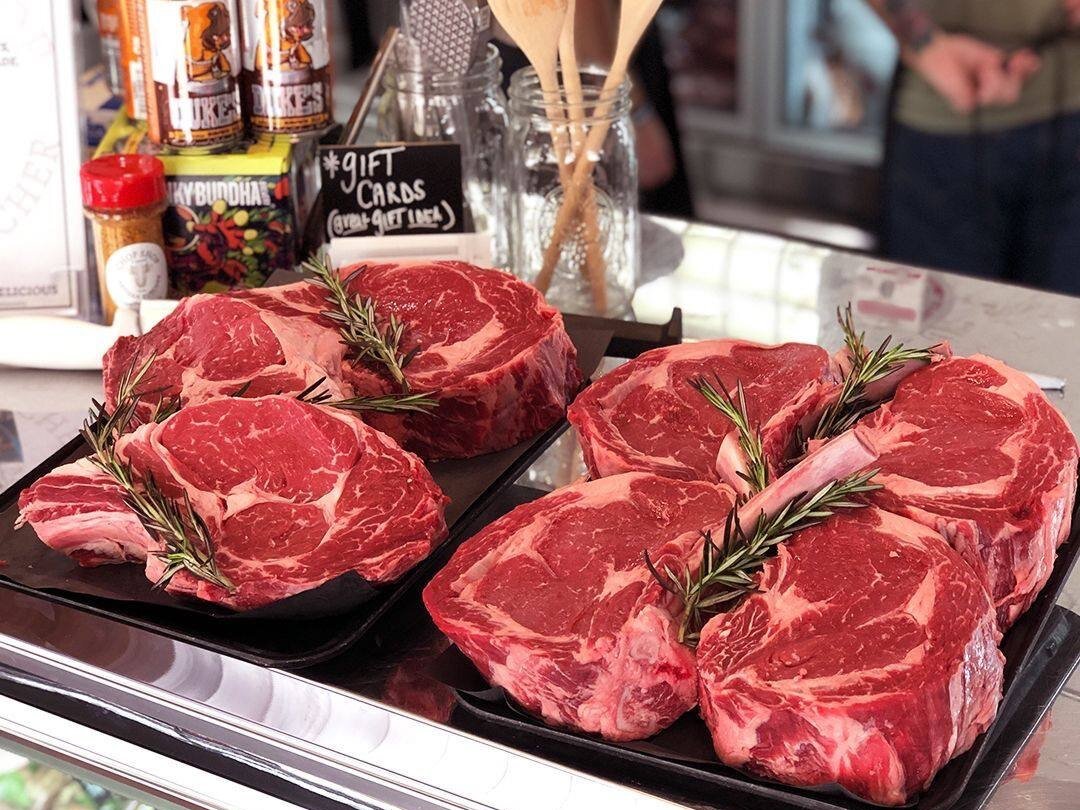
Beef Guides
FILET MIGNON
Almost everyone knows Filet Mignon to be one of the most popular (and coveted) cuts of beef. Here’s why: Filet, cut from the Tenderloin, is the most tender steak, and also one of the most rare.
This cut does not have much protective fat, so you want to cook the Filet quickly over high heat. The idea is to get a nice sear on the outside, while keeping the internal temperature to a juicy 130°F (medium rare).
BONELESS RIBEYE
The Ribeye is located at the upper part of the back closer to the shoulder. This is where you’ll find some of the most tender meat imaginable as it comes from softer, less-worked muscle fibers in the center of the steer.
High and fast is the name of the game here, so take the time to preheat your grill or cast iron pan. You want to get a quick sear on the outside of the steak and heat the internal temperature to 130°F (medium rare).
BONE-IN “COWBOY” RIBEYE
Any piece of meat with the bone left in has a slightly deeper flavor than if the bone is removed.
You want to get a quick high heat sear on the outside of the steak then finsih with indirect heat or in the oven to an internal temperature of 130°F (medium rare).
NEW YORK STRIP
The Strip comes from the back of the steer, where the muscles don’t get much of a workout. This creates an tender piece of meat, but still yields a beautiful, solid steak that has the popular appeal of a Filet, and the depth-of-flavor of the juicy Ribeye.
FLANK STEAK
You may have had Flank Steak in a London broil, in a taco, maybe atop a salad, or—a taco salad. Wherever you had it, it probably didn’t taste like this.
Tip: The Flank Steak has unique muscle fibers that create an incredible mouthfeel when cooked and cut correctly. Sear simply with salt and pepper or marinade for an extra level of flavor (just make sure to clean your marinate off before hitting high heat to avoid burning). After resting, take special care to cut against the grain for the most tender results.
TRI-TIP
The Tri-Tip has muscle fibers that have an amazing texture when sliced against the grain. The meat comes from the an area near the rear leg of the cattle, an area that stays tender and packed with flavor.
This cut works well as a quick-grilling steak or smoke low and slow. We like it best charred to a nice medium rare, and served with chimichurri sauce. Always let this cut rest for at least 10 minutes after cooking, and slice against the grain.
SIRLOIN/PETITE SIRLOIN
The Sirloin comes from the back part of the animal, where a muscle develops from moving around, roaming freely. This spot develops great flavor and provides a tender, juicy steak.
This cut is best served on the rarer side since it doesn't have much fat in or around it. Cook with high heat to develop a good char, but keep the inside nice and red. The more this cut cooks, the tougher it becomes.
MARINATED FILET TIPS
Simple enough to grill or cook in the cast iron. A quick sear on each side and you are good to go.
You can also use these whenever your recipe calls for cubed beef to instantly upgrade your dish and cut down on the cooking time.
SHOULDER ROAST
This roast comes from the beef's shoulder.
Low and slow is the name of the game. To achieve the desired tender perfection, you need to cook your roast to 180°F and keep it there for a few hours. This time allows the connective tissue time to break down and lessens the chance moisture will escape. While we know 165°F is cooked through, longer helps breakdown the muscle fibers.
STEW BEEF
Tip: Ideal for classics like beef bourguignon or the humble stew
Description: cut from a combination of shoulder & sirloin our stew meat is ideal for the 2hr braise. Our butchers carefully cut each piece into 1”cubes for consistent cooking and even browning.
HANGER STEAK
Tip: Salt and black pepper, then sear until blackened on the exterior, but medium rare within.
Description: often called the butcher’s cut, hanger steaks, as its name suggests, hang in the center of the steer’s body acting as the primary muscle in the diaphragm. This prized cut is well marbled and eats like a skirt steak with a more intense depth of flavor.
TERES MAJOR
The Teres Major is a butcher's cut from the shoulder of the cattle. The muscles around this small piece of meat are developed by the animal's active life on pasture, and because of this, the Teres Major has an amazing flavor. It is the second most tender cut after the filet.
This is a high and fast cook. Season the outside with salt and pepper and pre-heat some olive oil in a pan until it’s nice and hot. This cut takes under 10 minutes to cook and should be kept rare to medium rare. After resting, slice and sprinkle with some flake or finishing salt. Also a great cut for stroganoff or even stir fry.
BONELESS SHORT RIB
Short Ribs come from the rib cage of our cattle, specifically the rib plate. The meat on those ribs is desirable because it features a glorious combination of meat and fat. Cutting them down into two-inch pieces makes them easier to eat, share, cook, devour.
Low and slow is the name of the game. To achieve the desired fall-off-the-bone perfection, you'll need to cook your Short Ribs to 180°F, and keep it there for a few hours. The long cooking time allows connective tissue to break down, and lessens the chance moisture will escape. Braise with beef stock, carrots, onion, celery, herbs & spices and maybe even a little red wine.
BRISKET
The Whole Brisket is the pectoral muscle of the steer or heifer. This muscle gets a workout because of the lifestyle of our animals, making the cut very tough and extremely flavorful, which is why it’s perfect for slow-cooking methods like smoking or roasting. The Brisket consists of two different muscles connected with a nice strip of fat that cooks down, leaving you with an incredibly moist cut with deep flavor.
Low and slow is the name of the game. To achieve tender sliceable perfection, you need to cook your beef Brisket to 205°F, then rest it for at least an hour. This time allows the connective tissue to break down, and lessens the chance moisture will escape. If you prefer to smoke your Brisket, you always want to use real wood or wood chips and lump hardwood charcoal. You also want your meat to be as dry as possible before going on a smoker to build a good pellicle for the smoke to adhere to.
Pro Tip: Keep moisture in your smoker with a small pan of water or apple juice.
BEEF TALLOW
Tip: Use instead of cooking oil for roasting vegetables or searing your steak
Description: Rendered and clarified beef fat. Tallow is the fat derived from inside the cavity of a steer. It acts as a protective covering for the animals internal organs. When ground and rendered, beef tallow turns into a clear golden brown liquid that can be used as a richer alternative to typical cooking oil.
GROUND BEEF
EVERYTHING. AND WE'RE PROUD OF IT
Some use designer cuts to make their burgers sound more delicious, but it all comes down to the quality of the beef and the right mixture of fat and meat. Our burger is a whole-animal grind, which means we can use more of the steer, and serve you a more honest value. The high quality of our pasture-raised beef and the perfect fat ratio makes burgers that are unbelievably flavorful. Once you taste the difference, there’s no going back.
PICANHA
The Picanha is an incredible cut of meat from the back end of the cow and is part of the sirloin. It sits on top of the round near the back legs and is often neglected by lazy butchers. This hard working muscle develops great flavor, but make sure not to cook it too much.
This cut is great for grilling and feeding a crowd. Make sure you start with a hot grill. Place the roast fat side down until a nice char begins to form. Rotate as needed until you have a nice crust and the internal temperature hits 130°F. Remove from the grill and let it rest at least 15 minutes to let the juices redistribute. As with all cuts of beef, make sure you slice against the grain. If the Picanha is overcooked or sliced incorrectly, it can become chewy.
BEEF MARROW BONES
These boat-cut marrow bones are cut from the beef’s femur, which is the largest bone in the animal’s body.
Roast in a 450℉ oven 15-20 minutes to enjoy your Marrow Bones, or use your smoker to impart an extra layer of deliciousness. These bones can also be used to make your broth or stock extra rich and hearty.
BURGERS
EVERYTHING. AND WE'RE PROUD OF IT
Some use designer cuts to make their burgers sound more delicious, but it all comes down to the quality of the beef and the right mixture of fat and meat. Our burger is a whole-animal grind, which means we can use more of the steer, and serve you a more honest value. The high quality of our pasture-raised, dry aged beef, and the perfect fat ratio makes burgers that are unbelievably flavorful. Once you taste the difference, there’s no going back.
Season patties simply with salt and pepper then cook on the grill, or in a skillet, over high heat. Cook for 4-5 minutes on each side, top with your favorite condiments, then smile and enjoy the world’s greatest burger.
BEEF STOCK
Our beef stock is made with pasture-raised beef bones. We select the best knuckle, femur and rib bones to create a rich stock with loads of gelatin. Ingredients: beef bones, water, carrot, celery, onion, garlic, tomato paste, thyme, parsley, peppercorns and bay leaves.
Use this stock in any recipe calling for beef broth or stock, to add flavor and richness.
HOUSE DRY AGED BEEF
We dry age in house for you to see and taste the difference. We agePRIME Ribeye for 28 days to allow flavor to build by reducing the water content in the beef to create more beef flavor and for the natural enzymes in the beef to break down the muscle fibers to end up with an even more tender steak than regular PRIME beef.
View more Dry Aged Preparation Instructions HERE
